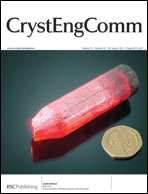The basal twin of α-Cr2O3 nanocondensates: occurrence and first-principles calculations†
Abstract
The α-Cr2O3 nanocondensates prepared by pulsed ![[1 with combining macron]](https://www.rsc.org/images/entities/char_0031_0304.gif) 10
10![[2 with combining macron]](https://www.rsc.org/images/entities/char_0032_0304.gif) ) surfaces. The cause of such a basal twin with a Burgers vector
) surfaces. The cause of such a basal twin with a Burgers vector ![[b with combining right harpoon above (vector)]](https://www.rsc.org/images/entities/b_i_char_0062_20d1.gif) = 1/3[
= 1/3[![[1 with combining macron]](https://www.rsc.org/images/entities/char_0031_0304.gif) 10] can be rationalized by the (0001)-specific rotation/coalescence of the crystalline nanocondensates to form a 2-D coincidence site lattice with an excess energy of 13 eV nm−2 according to first-principles density functional calculations. The unification/twinning bifurcation of the sesquioxide atom clusters that were previously coalesced can be explained by the critical particle size and the temperature for anchorage release at the interface.
10] can be rationalized by the (0001)-specific rotation/coalescence of the crystalline nanocondensates to form a 2-D coincidence site lattice with an excess energy of 13 eV nm−2 according to first-principles density functional calculations. The unification/twinning bifurcation of the sesquioxide atom clusters that were previously coalesced can be explained by the critical particle size and the temperature for anchorage release at the interface.


 Please wait while we load your content...
Please wait while we load your content...